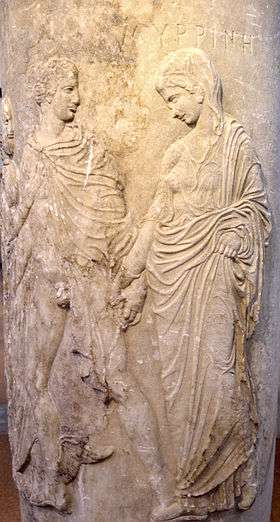Psychopomp

Psychopomps (from the Greek word ψυχοπομπός, psuchopompos, literally meaning the "guide of souls")[1] are creatures, spirits, angels, or deities in many religions whose responsibility is to escort newly deceased souls from Earth to the afterlife. Their role is not to judge the deceased, but simply to provide safe passage. Appearing frequently on funerary art, psychopomps have been depicted at different times and in different cultures as anthropomorphic entities, horses, deer, dogs, whip-poor-wills, ravens, crows, owls, sparrows and cuckoos. When seen as birds, they are often seen in huge masses, waiting outside the home of the dying.
Overview
Classical examples of a psychopomp are the ancient Egyptian god Anubis, the Greek ferryman Charon[1] and deities Hermes and Hecate, the Roman god Mercury, and the Etruscan deity Vanth. The form of Shiva as Tarakeshwara in Hinduism performs a similar role, although leading the soul to moksha rather than an afterlife. In many beliefs, a spirit being taken to the underworld is violently ripped from its body.[2]
The most common contemporary example of a psychopomp appearing in popular culture is the Grim Reaper, which dates from 15th-century England and has been adopted into many other cultures around the world over the years; for instance, the shinigami in Japanese culture today.[lower-alpha 1]
In Jungian psychology, the psychopomp is a mediator between the unconscious and conscious realms. It is symbolically personified in dreams as a wise man or woman, or sometimes as a helpful animal. In many cultures, the shaman also fulfills the role of the psychopomp. This may include not only accompanying the soul of the dead, but also to help at birth, to introduce the newborn child's soul to the world.[3](p36) This also accounts for the contemporary title of "midwife to the dying", or "End of Life Doula", which is another form of psychopomp work.
In Filipino culture, dead relations function as psychopomps. When the dying call out to specific dead persons (e.g. parents, partners), the spirits of the latter are supposedly visible to the former. The spirits, who traditionally wait at the foot of the deathbed, fetch (Tagalog: sundô) the soul soon after death and escort it into the afterlife.
Notes
- ↑ Exemplified by the popular manga and TV drama series Death Note
References
- 1 2 "ψυχοπομπός - Henry George Liddell, Robert Scott A Greek-English Lexicon". Perseus.tufts.edu.
- ↑ "The Mercury-Woden Complex: - A Proposal", p. 27
- ↑ Hoppál, Mihály: Sámánok Eurázsiában. Akadémiai Kiadó, Budapest, 2005. ISBN 963-05-8295-3. (The title means "Shamans in Eurasia"; the book is written in Hungarian, but it is published also in German, Estonian and Finnish.) Site of publisher with short description on the book (in Hungarian).
Further reading
- Geoffrey Dennis, "Abraham", "Elijah", "Lailah", "Sandalphon", Encyclopedia of Jewish Myth, Magic, and Mysticism, Llewellyn, 2007.
- Eliade, Mircea, "Shamanism", 1964, Chapters 6 and 7, "Magical Cures: the Shaman as Psychopomp".